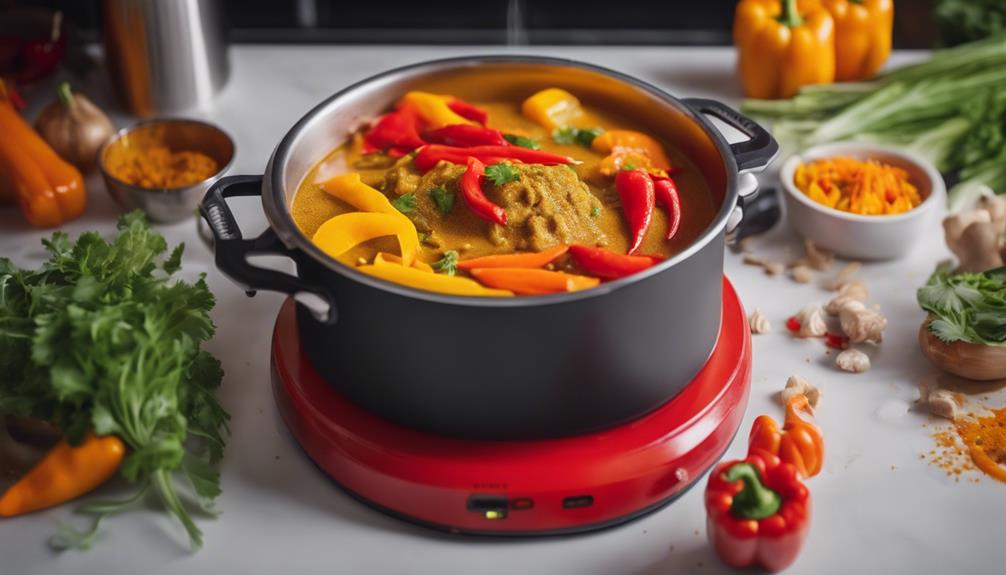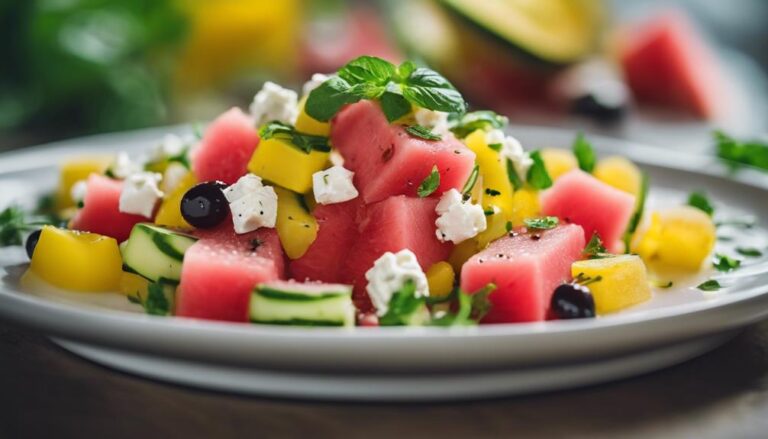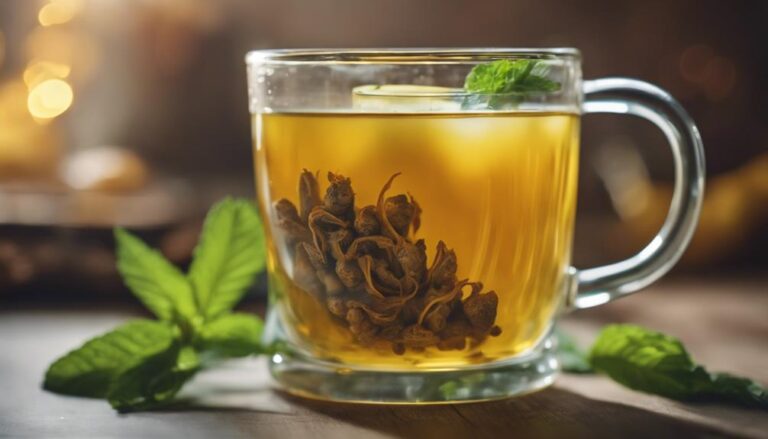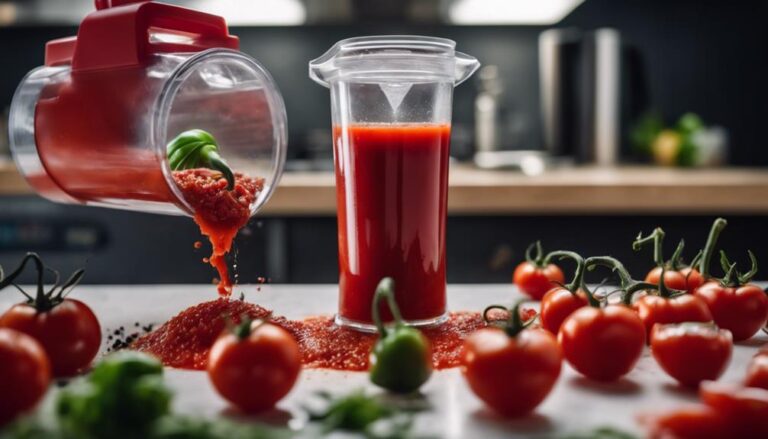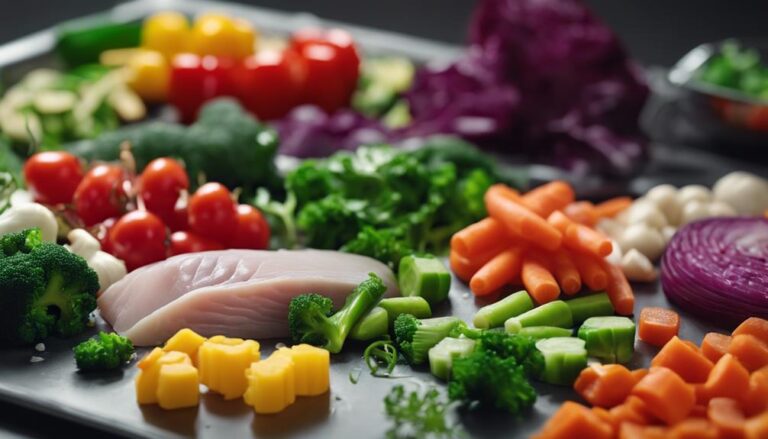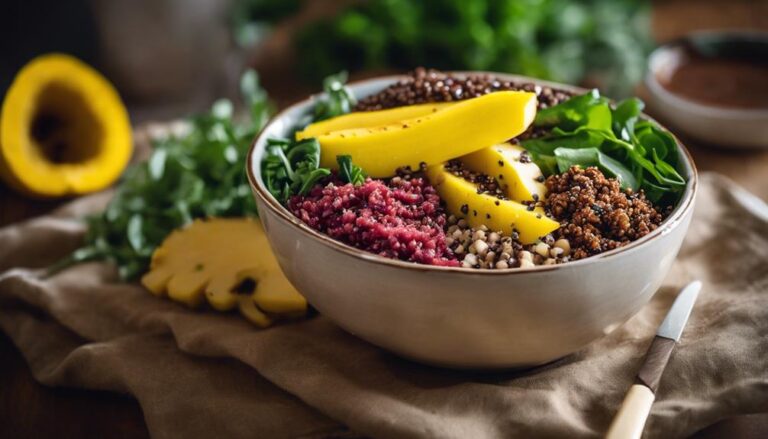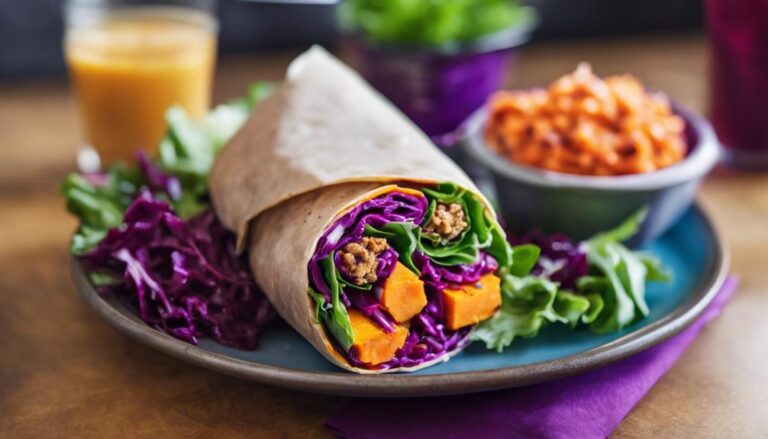Special Sous Vide Red Curry With Golden Vegetables
Imagine savoring a dish that harmoniously blends the richness of red curry with the vibrancy of golden vegetables, each bite bursting with nuanced flavors and tender textures. The art of sous vide cooking elevates this traditional Thai favorite to a new level, ensuring every ingredient is infused with the essence of the curry. Picture yourself indulging in a culinary journey where every element complements the next, creating a symphony of taste that lingers on your palate. As you explore the depths of this exquisite dish, you'll uncover layers of complexity that promise a dining experience unlike any other.
What You Will Learn Here
- Elevate traditional red curry with sous vide for tender meats and vibrant vegetables.
- Infuse flavors with aromatic herbs like lemongrass and galangal.
- Balance heat levels by adjusting Thai chilies and coconut milk.
- Experiment with spice infusion techniques for a dynamic culinary experience.
- Create a creamy, flavorful red curry with a perfect blend of exotic spices.
Culinary Origins
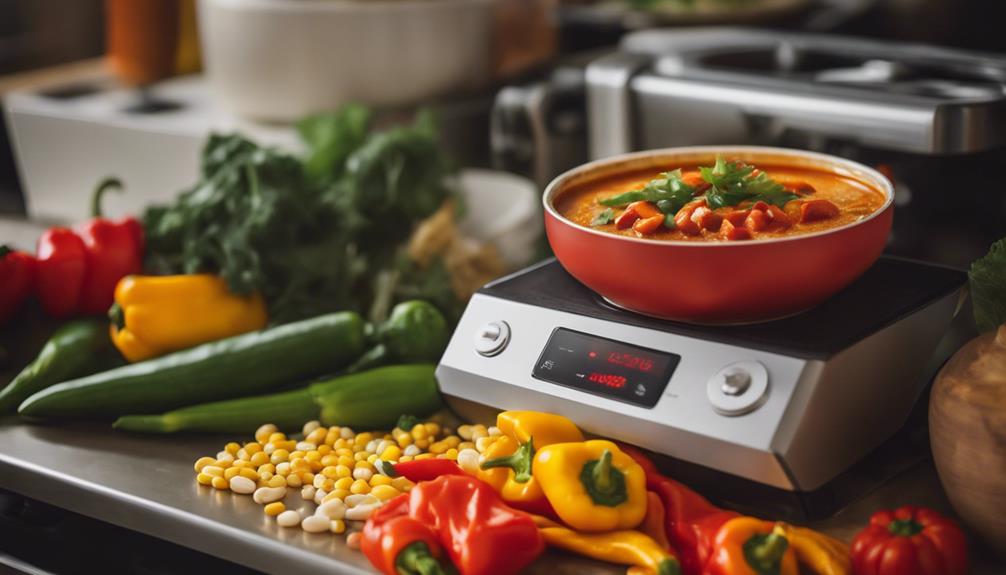
Thai Red Curry has deep roots in Thailand's rich culinary history, blending traditional spices and herbs with a modern twist.
The fusion of flavors in red curry showcases the harmonious marriage of spicy, sweet, and savory elements.
Exploring the origins of this dish reveals a culinary journey that spans generations of Thai tradition and innovation.
Thai Red Curry Roots
Originating from the vibrant culinary traditions of Thailand, red curry has a rich history rooted in the diverse flavors and ingredients of the region. Thai cuisine, known for its balance of sweet, sour, salty, and spicy flavors, heavily influences the creation of red curry. Cultural influences from neighboring countries like India and China also play a significant role in shaping the distinct taste profile of this beloved dish.
The use of aromatic herbs and spices such as lemongrass, galangal, and kaffir lime leaves characterizes Thai red curry, infusing it with layers of complex flavors. These ingredients, combined with the creamy richness of coconut milk, create a harmonious blend that's both comforting and exotic.
The vibrant colors of the curry, derived from red chilies and turmeric, further showcase the visual appeal of Thai cuisine. Thai red curry's origins extend deep into the culinary heritage of Thailand, reflecting the country's diverse cultural influences and the ingenuity of its people in combining unique ingredients to create a dish that's cherished worldwide.
Fusion of Flavors
Explore the intricate fusion of flavors that form the foundation of red curry's culinary origins. Thai red curry is renowned for its flavorful combinations that result from a vital blend of traditional ingredients like lemongrass, galangal, and kaffir lime leaves. The creative cooking techniques used in preparing red curry involve pounding these aromatic herbs and spices into a paste, which is then simmered with creamy coconut milk to create a rich and fragrant sauce.
The fusion of flavors in red curry reflects the influence of various culinary traditions, including Indian, Chinese, and Malay, which have shaped Thai cuisine over centuries. The spiciness of red curry paste, derived from dried red chilies, pairs beautifully with the sweetness of coconut milk and the freshness of Thai basil and cilantro.
Through the skillful combination of herbs, spices, and other key ingredients, red curry captivates the palate with its complex yet balanced taste profile. This flavorful dish showcases the artistry of Thai cuisine, where each ingredient plays an essential role in creating a symphony of tastes that delight the senses.
Modern Culinary Twist
Blend traditional flavors with a contemporary flair by infusing innovative culinary techniques into the classic red curry recipe. Sous vide techniques offer a modern twist to traditional dishes, allowing flavors to intensify and ingredients to cook evenly. By incorporating this method into your red curry preparation, you can elevate the dish to new heights.
Innovative cooking methods provide a fresh perspective on classic recipes, breathing new life into familiar flavors. Experimenting with sous vide in your red curry creation can result in tender meats, vibrant vegetables, and a more nuanced sauce profile. The controlled temperature of the sous vide process guarantees that each component reaches perfection without overcooking or losing essential nutrients.
Key Curry Paste Ingredients
Enhance the flavor profile of your red curry by incorporating essential ingredients in the curry paste. When preparing your curry paste, consider these key elements to elevate the taste of your dish:
- Fresh Thai chilies: Add a spicy kick to your curry paste for an authentic Thai flavor.
- Galangal: This root adds a citrusy, piney taste, distinct from ginger, for a unique twist.
- Kaffir lime leaves: Infuse your paste with an invigorating citrus aroma for a burst of freshness.
- Lemongrass: Incorporate this herb for a subtle, lemony taste that enhances the overall profile of your curry.
- Shrimp paste: For an umami-rich element, include shrimp paste in your curry paste to deepen the flavors.
Experiment with these ingredients to create a curry paste that forms the foundation of a delicious red curry. By understanding these essential components, you can achieve a balance of flavors that complements various ingredients and cooking techniques, allowing you to explore both traditional recipes and creative combinations for a flavorful culinary experience.
Top-Rated Curry Creations
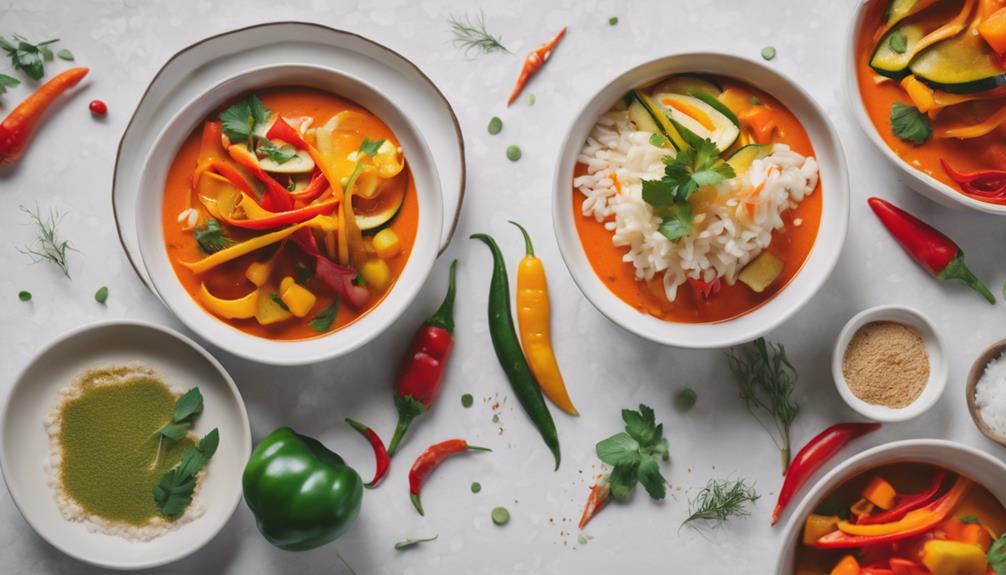
Explore some of the top-rated curry creations, including the Exotic Red Curry Blend, the delightful Golden Vegetable Curry Recipe, and the satisfying Vegan Coconut Curry.
These dishes offer a range of flavors and textures that cater to various preferences, from spicy and aromatic to creamy and comforting.
Whether you're a curry connoisseur or looking to try something new, these recipes are sure to tantalize your taste buds.
Exotic Red Curry Blend
Get ready to elevate your culinary creations with the vibrant flavors of the top-rated Exotic Red Curry Blend. This exceptional blend of spices brings together a harmonious fusion of spice origins and cultural influences, resulting in a truly unique and exotic flavor profile that will transport your taste buds to far-off lands.
Here are some key points to keep in mind when working with this exquisite blend:
- Spice Origins: The Exotic Red Curry Blend combines spices from diverse regions, including India, Thailand, and Indonesia, creating a rich tapestry of flavors that reflect the vibrant culinary traditions of these cultures.
- Cultural Influences: Explore the cultural significance behind each spice in the blend and how it contributes to the overall complexity and depth of the curry.
- Flavor Pairings: Experiment with different ingredients to find the perfect flavor pairings that complement the bold and aromatic notes of the Exotic Red Curry Blend.
- Recipe Variations: From traditional curry dishes to innovative fusion recipes, the possibilities are endless when using this versatile blend in your cooking.
- Creative Applications: Think outside the box and consider unconventional ways to incorporate the Exotic Red Curry Blend into your dishes for a truly memorable dining experience.
Golden Vegetable Curry Recipe
Discover a delectable Golden Vegetable Curry recipe that will tantalize your taste buds with its aromatic flavors and vibrant colors. This curry creation allows for various vegetable variations, making it a versatile dish to suit your preferences.
By utilizing different curry cooking techniques, you can explore new ways to enhance the flavors of this delightful meal. When preparing this Golden Vegetable Curry, consider incorporating seasonal ingredients to enjoy the freshest produce available.
For those who enjoy a bit of heat, don't forget to experiment with spicy additions to elevate the overall taste profile. Here are some key points to keep in mind:
- Explore a range of vegetable variations to customize your curry.
- Experiment with different curry cooking techniques for unique flavors.
- Utilize seasonal ingredients to enhance the freshness of your dish.
- Add spicy additions for those who enjoy a kick of heat in their curry.
- Enjoy the vibrant colors and aromatic flavors of this Golden Vegetable Curry recipe.
Vegan Coconut Curry Delight
Indulge in the velvety richness of Vegan Coconut Curry Delight, a top-rated culinary creation that promises to tantalize your taste buds with its flavorful blend of coconut-infused goodness. This plant-based delight offers a creamy coconut base that harmonizes perfectly with a medley of fresh vegetables and aromatic spices.
Here are five reasons why this dish stands out:
- Bursting with the creamy richness of coconut milk
- Packed with a vibrant array of colorful vegetables
- Infused with a delightful blend of exotic spices
- Offers a satisfying and wholesome plant-based meal option
- Provides a perfect balance of flavors and textures
Whether you're a seasoned vegan enthusiast or simply looking to explore new culinary horizons, Vegan Coconut Curry Delight is sure to impress with its harmonious fusion of flavors and textures.
Give your taste buds a treat with this delectable coconut curry creation that celebrates the beauty of plant-based cooking.
Enhancing Curry Flavor
To enhance the flavor of your curry, consider using spice infusion techniques like blooming spices in oil or dry toasting them for a robust taste. Experiment with aromatic ingredients such as lemongrass, ginger, and garlic to add layers of complexity to your dish.
Remember to balance the heat levels by adjusting the amount of chili peppers or adding coconut milk for a creamy, milder flavor profile.
Spice Infusion Techniques
Consider experimenting with different spice infusion techniques to elevate the flavor of your red curry and create a more dynamic culinary experience. Through Sous Vide cooking, you can intensify the infusion process, allowing the flavors to penetrate deeply into the ingredients.
This method involves sealing the spices with the main components of the dish in a vacuum-sealed bag and then cooking them at precise temperatures for an extended period. It results in a more concentrated and nuanced taste profile.
When choosing flavor pairings and spice blends for your red curry, think about complementary ingredients that will enhance the overall taste. For instance, consider combining traditional Thai spices like lemongrass, galangal, and kaffir lime leaves with a touch of sweetness from coconut milk and a hint of heat from red chilies.
This harmonious blend of flavors will create a well-rounded and authentic red curry experience. Experiment with different combinations to find the perfect balance that suits your palate.
Aromatics and Herbs
Enhance the flavor of your red curry by incorporating a variety of aromatic herbs to create a vibrant and aromatic culinary experience. When selecting herbs to elevate your curry, consider herb pairings that complement the dish's flavor profiles.
For a traditional red curry, Thai basil, cilantro, and lemongrass are excellent choices. Thai basil adds a hint of licorice flavor, while cilantro brings a fresh, citrusy note. Lemongrass contributes a subtle lemony taste that enhances the overall aroma of the curry.
If you prefer a more robust and earthy flavor profile, you can opt for herb pairings like bay leaves, rosemary, and thyme. Bay leaves provide a slightly floral and herbal undertone, while rosemary offers a piney and woody flavor. Thyme brings a warm and aromatic essence to the curry, enriching its depth of flavor.
Experimenting with different herb combinations allows you to tailor the curry to your preferences, creating a unique and delightful culinary experience with each variation.
Balancing Heat Levels
For a well-rounded red curry dish, ensuring the right balance of heat levels is key to enhancing the overall flavor profile. Achieving the perfect flavor balance in your red curry relies on careful ingredient selection and heat control based on your taste preferences.
When selecting ingredients, consider the type and amount of chili peppers used, as they've a substantial impact on the curry's spiciness. Thai bird's eye chilies bring intense heat, while milder options like red bell peppers offer a more subtle kick.
To control the heat levels in your curry, start by adding small amounts of chili and gradually increase based on your taste preferences. Remember, you can always add more heat but reducing it once it's too spicy can be challenging.
Balancing the heat with creamy coconut milk and tangy lime juice can help mellow out the spiciness while enhancing the overall depth of flavors. Experiment with different chili varieties and quantities to find the perfect level of heat that suits your palate.
Final Thoughts
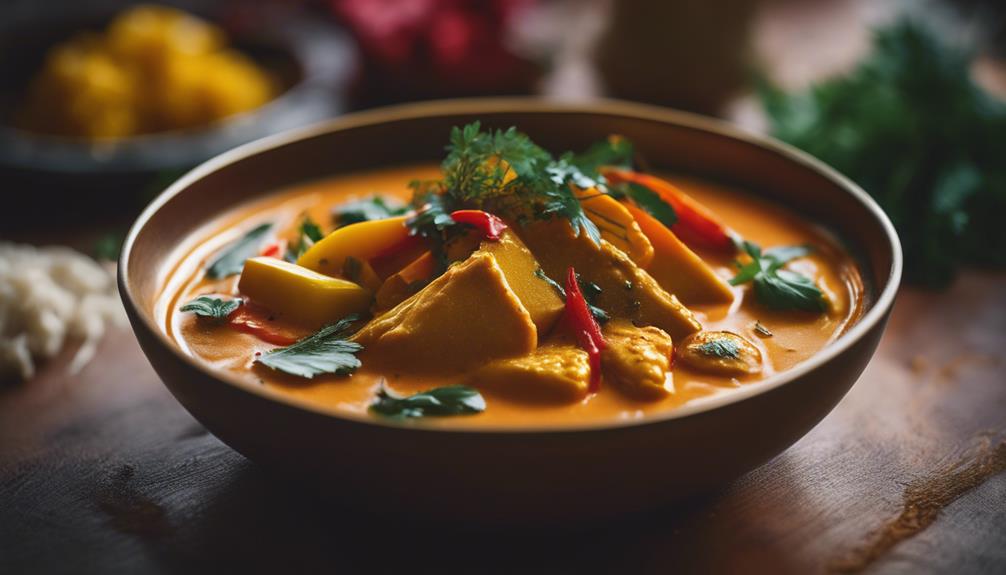
As you reflect on the culinary journey of creating this Sous Vide Red Curry With Golden Vegetables, remember to savor the vibrant flavors and textures that have come together in this delightful dish.
The culinary reflections you may have could range from the aromatic spices slowly infusing into the vegetables to the tender, perfectly cooked ingredients that sous vide cooking method has helped achieve. Each bite tells a story of care and precision in the kitchen.
When exploring recipe variations for this red curry, consider experimenting with different vegetables to add your own twist. You could try incorporating bamboo shoots for a more earthy flavor or adding pineapple for a touch of sweetness that balances the heat of the curry paste.
Don't be afraid to make this dish your own by adjusting the spice levels or exploring new ingredient combinations. The beauty of cooking is in the freedom to create something uniquely yours, so have fun with it!
Frequently Asked Questions
Can I Use a Regular Pot Instead of a Sous Vide Machine?
You can use a regular pot instead of a sous vide machine, but keep in mind that it won't provide the precise temperature control or even cooking that sous vide offers. The benefits of sous vide include consistent results and enhanced flavors.
How Can I Adjust the Spice Level for Milder Curry?
To adjust the spice level for milder curry, balance flavors by reducing chili powder or using less spicy peppers. Opt for mild curry paste or coconut milk. Experiment with ingredient alternatives to suit your taste preferences and modify the recipe accordingly.
Can I Substitute Coconut Milk With Another Ingredient?
Yes, you can substitute coconut milk with dairy alternatives like almond milk or cashew cream for a lighter flavor. Experiment with various options for flavor modifications to find the perfect balance for your curry dish.
What Vegetables Work Best With Red Curry?
For red curry, the best proteins are chicken, shrimp, or tofu. Vegetables like bell peppers, bamboo shoots, and eggplant work well. Stir-fry or sauté the veggies for a burst of flavor in your curry.
Is It Necessary to Marinate the Ingredients Before Sous Vide Cooking?
Before sous vide cooking, marinating benefits can enhance flavors. If you're short on time, consider using a vacuum sealer for a quick marinade or infusing flavors directly into the sous vide bag for alternatives.
Conclusion
Experience the perfect blend of traditional Thai flavors and modern cooking techniques with our Special Sous Vide Red Curry With Golden Vegetables. Elevate your dining experience with this plant-based meal option that's both flavorful and innovative.
Indulge in the vibrant colors and aromatic herbs and spices that make this curry a culinary delight. Treat yourself to a delicious and satisfying dish that will leave your taste buds wanting more.
